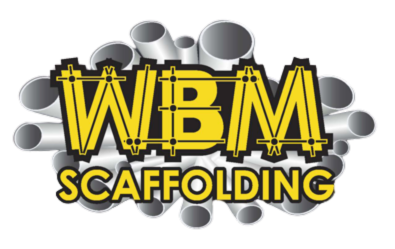If you’re thinking about becoming a scaffolder or hiring one for a project, it’s important to understand the skills and training involved. Scaffolding is a high-risk job, and in the UK, scaffolders are required to meet specific health and safety standards. In this blog, we’ll break down what qualifications scaffolders need, how they get trained, and what clients should check before hiring someone.
Whether you’re planning to enter the trade or searching for a trusted team near Ashford, this guide will help you understand what’s involved and why qualifications matter.
Why Are Scaffolder Qualifications Important?
Scaffolding involves working at height, handling heavy equipment, and building structures that support other tradespeople. Poor scaffolding can lead to injuries, accidents, and legal issues. This is why qualified scaffolders are essential on any safe construction site.
Proper qualifications show that a scaffolder:
- Understands current UK health and safety regulations
- Can assemble, inspect, and dismantle scaffolding safely
- Has completed practical and theory-based training
- Knows how to work with different types of scaffold systems
Starting Out: The Entry Requirements
There are no formal GCSE requirements to become a scaffolder, but employers often look for basic maths and English skills. Good physical fitness, awareness of heights, and a willingness to work outdoors in all weather are also key.
Many scaffolders begin as labourers or scaffold assistants. This role allows them to learn the ropes while supporting a more experienced scaffolder on-site.
The Main Scaffolding Qualifications
In the UK, scaffolders typically follow a structured path of qualifications. The two most important are:
1. CISRS (Construction Industry Scaffolders Record Scheme)
CISRS is the industry-recognised training scheme for scaffolders in the UK. It ensures workers are trained to build and manage scaffolding in line with national safety standards.
There are different levels within CISRS:
a) CISRS Labourer Card
This is for those just starting out. It allows someone to work under supervision, helping scaffolders load, carry, and organise materials.
To get this card, you need to:
- Complete a CISRS Operatives Training Scheme (COTS) course (1 day)
- Pass a Health, Safety and Environment (HS&E) test
b) CISRS Part 1 Scaffolder
This is the first formal step toward becoming a qualified scaffolder.
To qualify, you need:
- At least 6 months’ site experience
- A 10-day Part 1 training course
- An updated HS&E test pass
c) CISRS Part 2 Scaffolder
This covers more advanced structures like bridging scaffolds and loading bays.
You’ll need:
- 6 months’ experience after Part 1
- A 10-day Part 2 course
- Continued on-site experience
d) CISRS NVQ Level 2
After completing Parts 1 and 2, scaffolders must achieve an NVQ Level 2 Diploma in Scaffolding. This is a work-based qualification that shows real on-site ability.
e) CISRS Scaffolder Card (Blue Card)
Once all the above are complete, scaffolders receive their full CISRS card, allowing them to work unsupervised on-site.
2. Advanced Scaffolder (CISRS)
For more complex scaffolding projects like suspended scaffolds, temporary roofs, and complex designs, scaffolders must complete the CISRS Advanced course and NVQ Level 3.
This level is required for team leaders, supervisors, or those managing larger sites.
Here are some images of these cards:
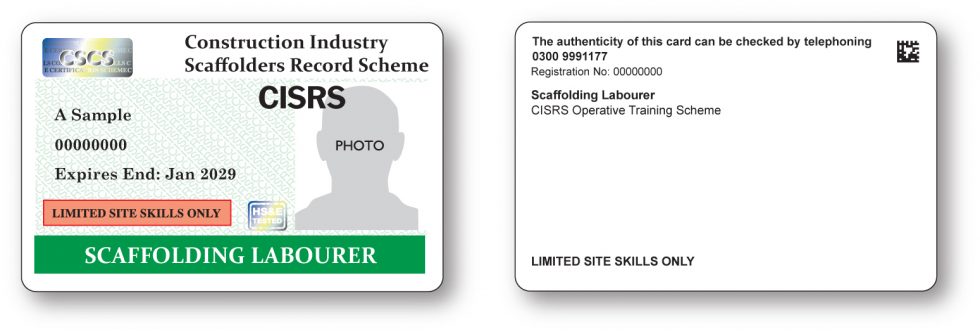
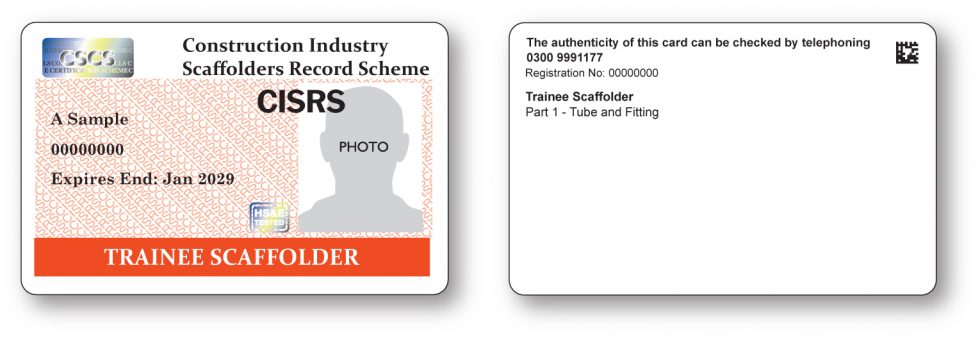
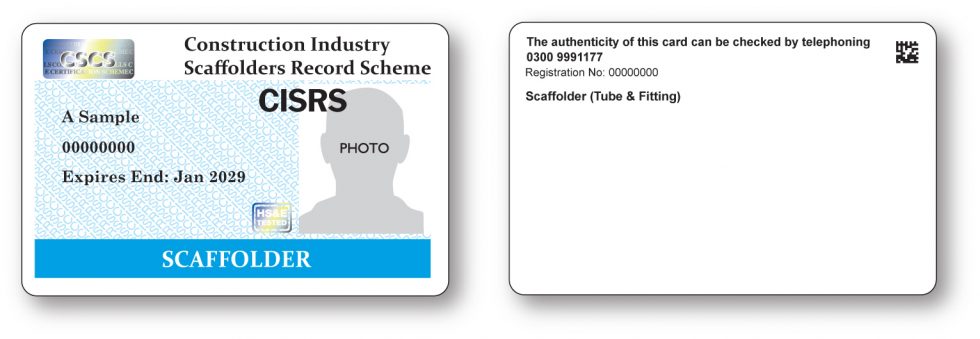
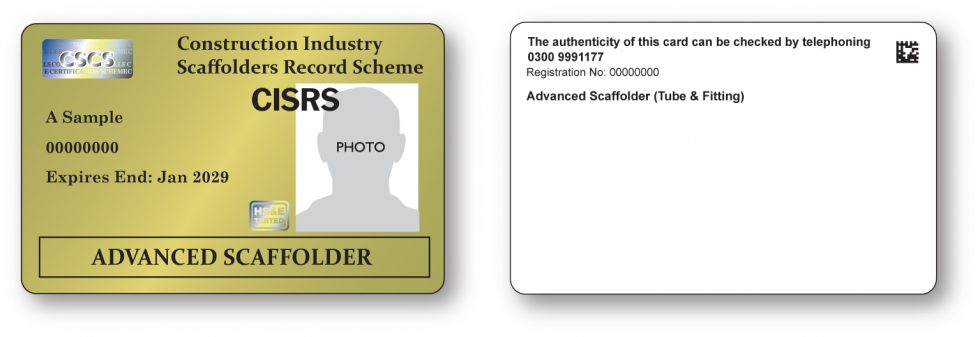
Additional Qualifications & Courses
Besides CISRS, other useful qualifications include:
- First Aid at Work: Vital for emergencies on-site
- Working at Height Awareness: Covers how to avoid accidents
- Manual Handling: Teaches safe lifting techniques
- Confined Spaces Training: For work in tight or restricted areas
- SSSTS (Site Supervisor Safety Training Scheme): Ideal for those moving into site management
These qualifications can give scaffolders an edge when applying for jobs or contracts.
Scaffolding Apprenticeships
A popular route into the trade is through a scaffolding apprenticeship. These usually last 18–24 months and combine paid work with structured training.
Apprentices learn about:
- Scaffold assembly techniques
- Health and safety legislation
- Equipment handling
- Risk assessments and inspections
Local firms like ours may take on apprentices depending on availability. It’s a good route for young people looking to build a hands-on career.
How Can You Check a Scaffolder’s Qualifications?
If you’re hiring a scaffolder or a team, always ask for proof of:
- CISRS cards
- Insurance details
- Relevant training certifications
A reputable scaffolding firm will be happy to show credentials and explain how their team is trained. You can also check reviews on Checkatrade or Facebook to confirm their reliability.
What Happens If Someone Works Without Qualifications?
Unqualified scaffolders put everyone at risk. If an accident happens, and the person involved wasn’t properly trained, you could face fines or liability claims. For businesses, this could even lead to worksite shutdowns or loss of contracts.
Hiring a qualified scaffolder not only ensures safetyit also protects you legally.
Why Experience Also Matters
While qualifications are key, experience is just as important. A good scaffolder has the skill to adapt to different buildings, ground conditions, and weather. They’ll know how to problem-solve, communicate with other trades, and keep the site running smoothly.
That’s why it’s smart to choose a company with both credentials and a strong track record in your local area.
Choosing a Scaffolding Company in Ashford
If you’re based in or near Ashford, look for scaffolders who are both qualified and familiar with local needs. Ashford includes older buildings, new housing estates, narrow streets, and commercial developments all of which require different scaffold solutions.
Here are a few things to check:
- Do they have a Google Business profile?
- Do they offer full CISRS-qualified teams?
- Are they active on Instagram and regularly post real work?
- Are their reviews consistent and recent?
How WBM Scaffolding Ensures Qualifications & Safety
At WBM Scaffolding, all our scaffolders hold valid CISRS cards and have passed relevant health and safety tests. We support continuous training and ensure every project meets UK regulations.
Our team is:
- Fully insured and qualified
- Experienced in domestic and commercial scaffolding
- Committed to safe, tidy, and efficient work practices
If you’d like to speak to us about a project, contact us here. We’re based in Ashford and serve the wider Kent area with tailored scaffold solutions for all building types.
Summary
Here’s a quick checklist of what scaffolders qualifications you should look for:
| Qualification | What It Allows |
|---|---|
| CISRS Labourer Card | Entry-level site work under supervision |
| CISRS Part 1 & 2 | Safe erection and dismantling of scaffolding |
| NVQ Level 2 in Scaffolding | Full practical scaffolder certification |
| CISRS Scaffolder Card | Unsupervised scaffolding work |
| Advanced Scaffolder | Complex or large-scale scaffolding |
| Additional training | First Aid, Manual Handling, Working at Height |
